|
(Richard et al. 2006, Stark et al. 2007, Richard et al. 2008). (Richard et al. 2007, Limousin et al. 2007, Richard et al. 2009) (Stark et al. 2008, Nature) (Richard et al. 2004, SPIE, Richard et al. 2006, SPIE) |

Example of lensing cluster (Abell 2218) showing some arc-shaped features which
are distorded and magnified images of background sources observed by strong-lensing effect. The magnification effect is the strongest at the vicinity of the critical line, shown here in red for a source at z=1.0
|
I am involved in different projects searching for the earliest galaxies formed during, or shorlty after, the cosmic reionization epoch. Characterizing the nature, physical properties, and epoch of formation of these sources, probably responsible for reionizing the intergalactic medium, is one of the latest challenges of modern cosmology. Extending the searches beyond z~6.5 and back to ages where the Universe re-ionised requires extremely deep observations in the near-IR bands. Until the construction of JWST and 20-40 meter class ground-based telescopes, gravitational lensing surveys offer the only possibility of spectroscopically verifying the presence of an abundant population of low-luminosity sources.
I conducted or largely contributed to three projects targetting the central regions of strong lensing clusters to search for very high redshift objects:
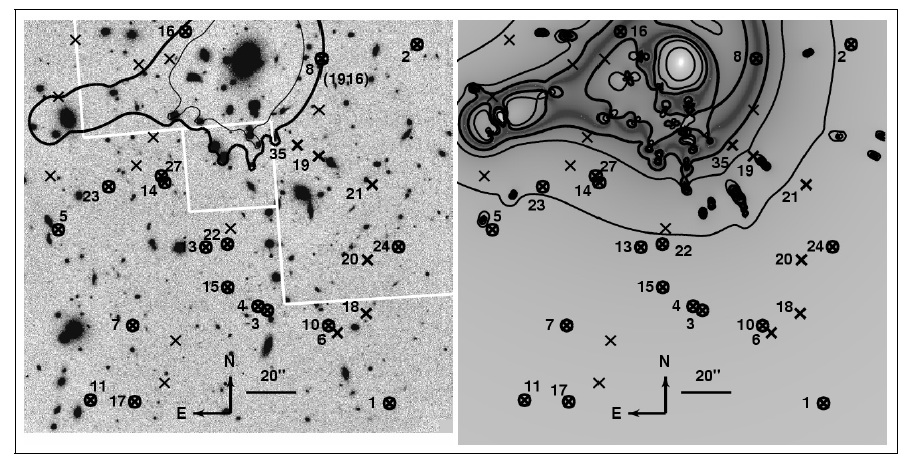 Location of the candidates (left), and corresponding magnification map (right),
with respect to the z~2.5 and z~9 critical lines.
Contours on the right are spaced by 0.5 magnitudes of magnification.
Location of the candidates (left), and corresponding magnification map (right),
with respect to the z~2.5 and z~9 critical lines.
Contours on the right are spaced by 0.5 magnitudes of magnification.
|
 Constraints on the UV Luminosity Function of high redshift galaxies.
Constraints on the UV Luminosity Function of high redshift galaxies.
|
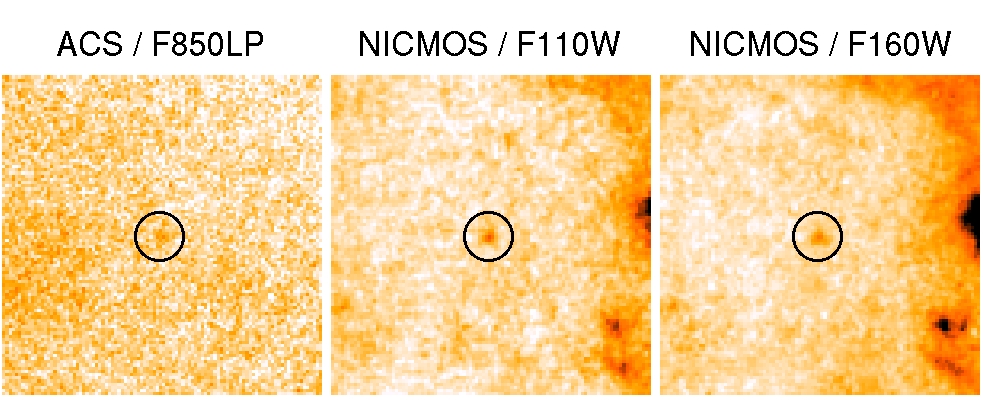
Snapshot images showing the average spectral energy distribution of the candidates in each ACS/NICMOS filter.
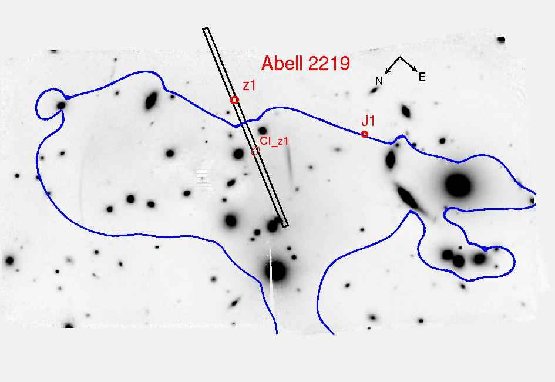 Coverage of the central region of one cluster with NICMOS, the high redshift
critical line is shown in blue.
Coverage of the central region of one cluster with NICMOS, the high redshift
critical line is shown in blue.
|
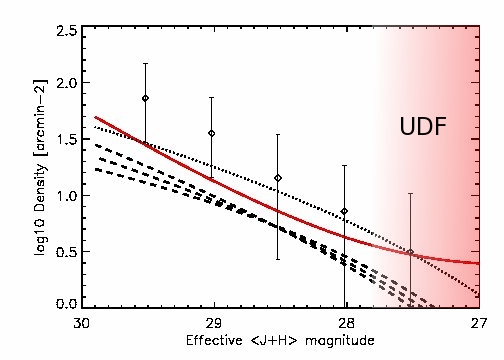 Constraints on the abundance of dropouts from this survey. The luminosities probed,
after correction by the magnification factors, are up to 2 magnitudes fainter than
the Ultra Deep Field (UDF).
Constraints on the abundance of dropouts from this survey. The luminosities probed,
after correction by the magnification factors, are up to 2 magnitudes fainter than
the Ultra Deep Field (UDF).
|
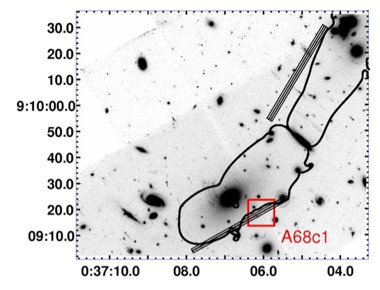
Spectroscopic coverage with NIRSPEC for one of the clusters (Abell 68), showing the location of one candidate and the high redshift critical line. |
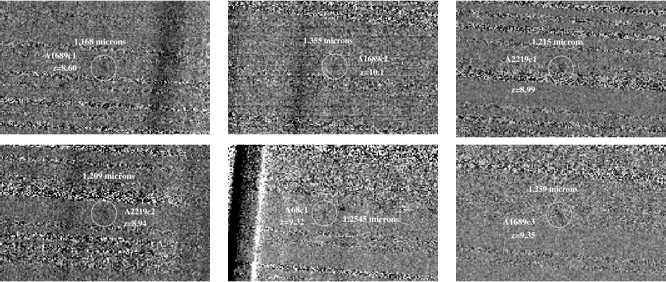 Zoom on the 2d spectra of 6 candidate Lyman-alpha emitters found in this survey.
Zoom on the 2d spectra of 6 candidate Lyman-alpha emitters found in this survey.
|
I have used the LENSTOOL software to constrain the mass distribution of several lensing clusters, in particular as part of the MACS and the LoCuSS collaborations. I concentrated on measuring the redshifts of the largest number of multiple images identified in each cluster, using mainly the LRIS instrument on the Keck telescope.
Here are a few example of results obtained for individual clusters:

The modelling of lensing clusters constrain the mass distribution
using the positions and redshift of multiple images. Going backward, a well-constrained mass model can predict the redshift for an additional multiple image.
|
 (Richard et al. 2007) |
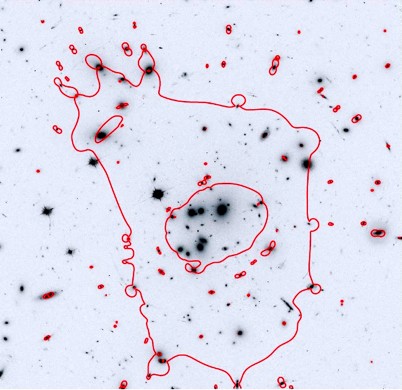
(Limousin, Richard et al. 2007) |

(Richard et al. 2009) |
With collaborators at Caltech (Richard Ellis, Tucker Jones), Durham (Mark Swinbank, Ian Smail) and Cambridge (Dan Stark), we have been performing a survey of the brightest z>2 arcs in clusters, taken from the LoCuSS and MACS surveys (see above), in order to study their physical properties in great details.
Indeed, studying the internal properties, in particular the dynamics of these high redshift galaxies enable to test galaxy formation models. Dynamics enables to distinguish between chaotic and well-ordered velocity fields, depending on the maturity of the systems. Gravitational magnification provides a large increase in angular size, enabling to reach source plane resolutions of ~100 pcs. Our survey strategy is the following:
- Use HST snapshot images to identify bright strongly lensed arcs and other multiple systems
- Perform Optical Spectroscopy using Keck/LRIS or VLT/FORS to measure their redshifts, extinction, line strengths, star-formation rates, and metallicities
- Screen the best candidates with near-infrared spectroscopy (using Keck/NIRSPEC): measures the abundances, star-formation rates and extinction independently
- Select the brightest near-infrared emission lines for Integral Field Unit (IFU) follow-up, using the Keck/OSIRIS and VLT/SINFONI near-infrared IFUs: this allows to measure the resolved dynamics in these objects
- Other follow-up observations include: further HST images to study the resolved stellar populations, measurements of CO and radio continuum, mid-infrared spectroscopy with Spitzer/IRS
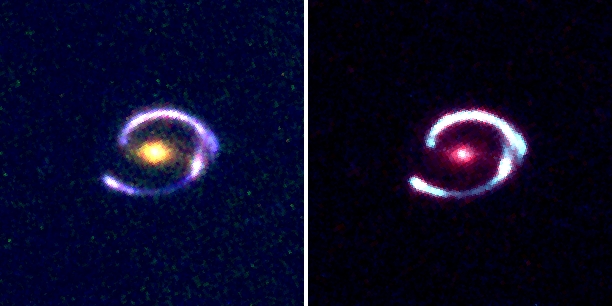
|

(Smail et al. 2007) |

(Stark et al. 2008, Nature) |